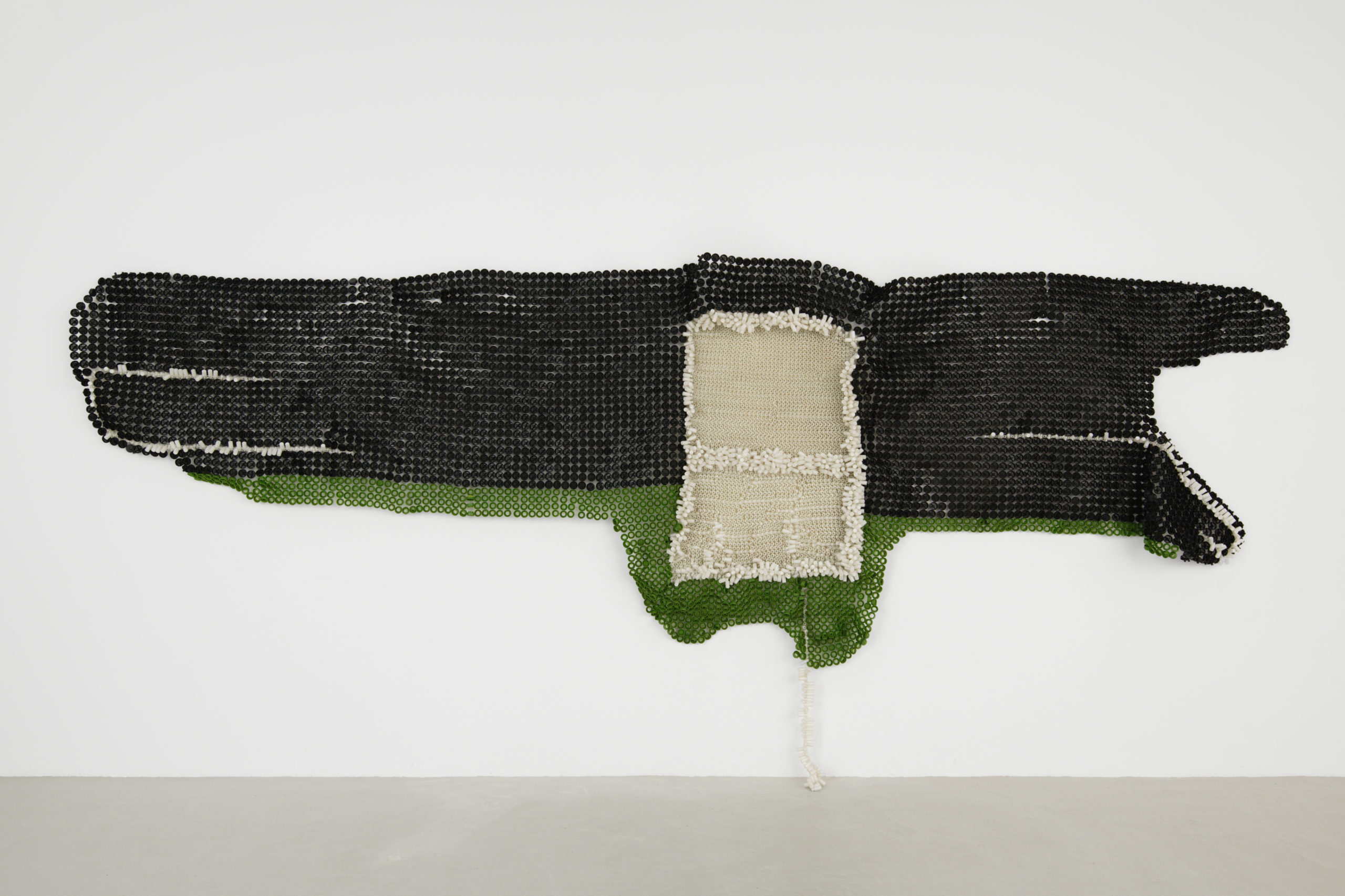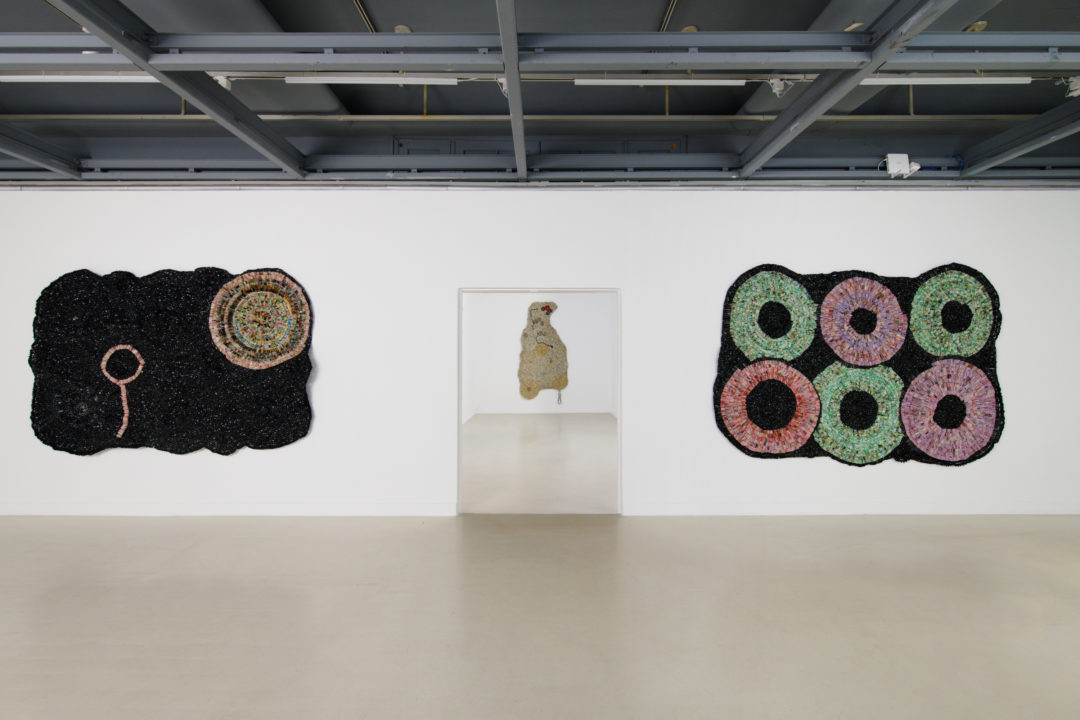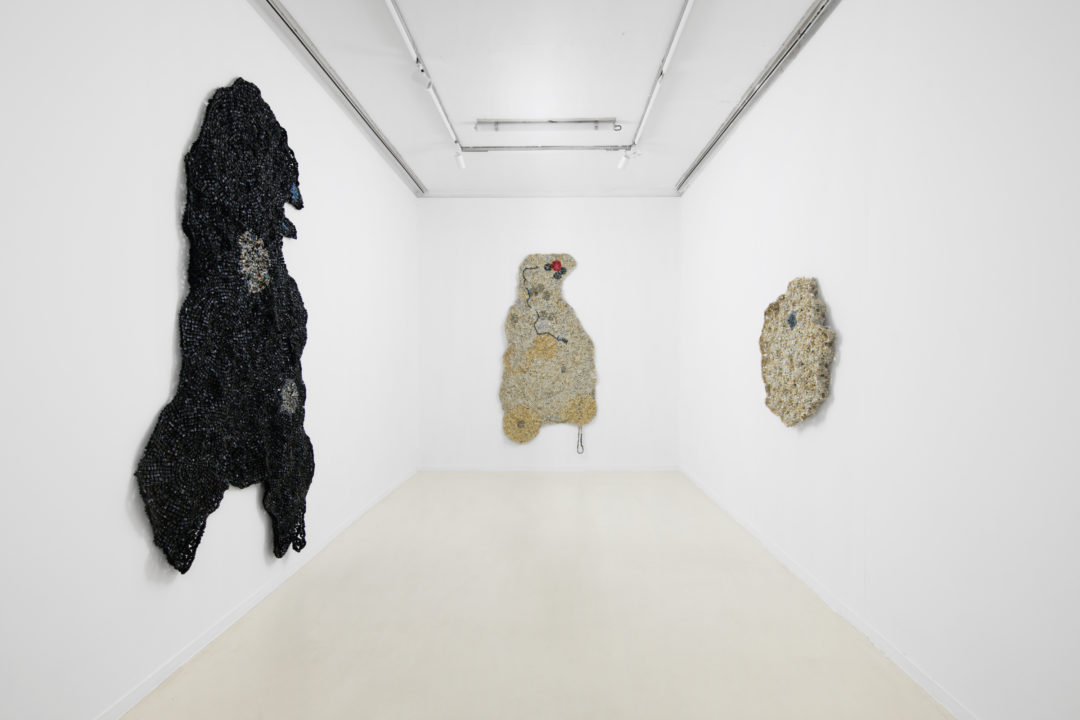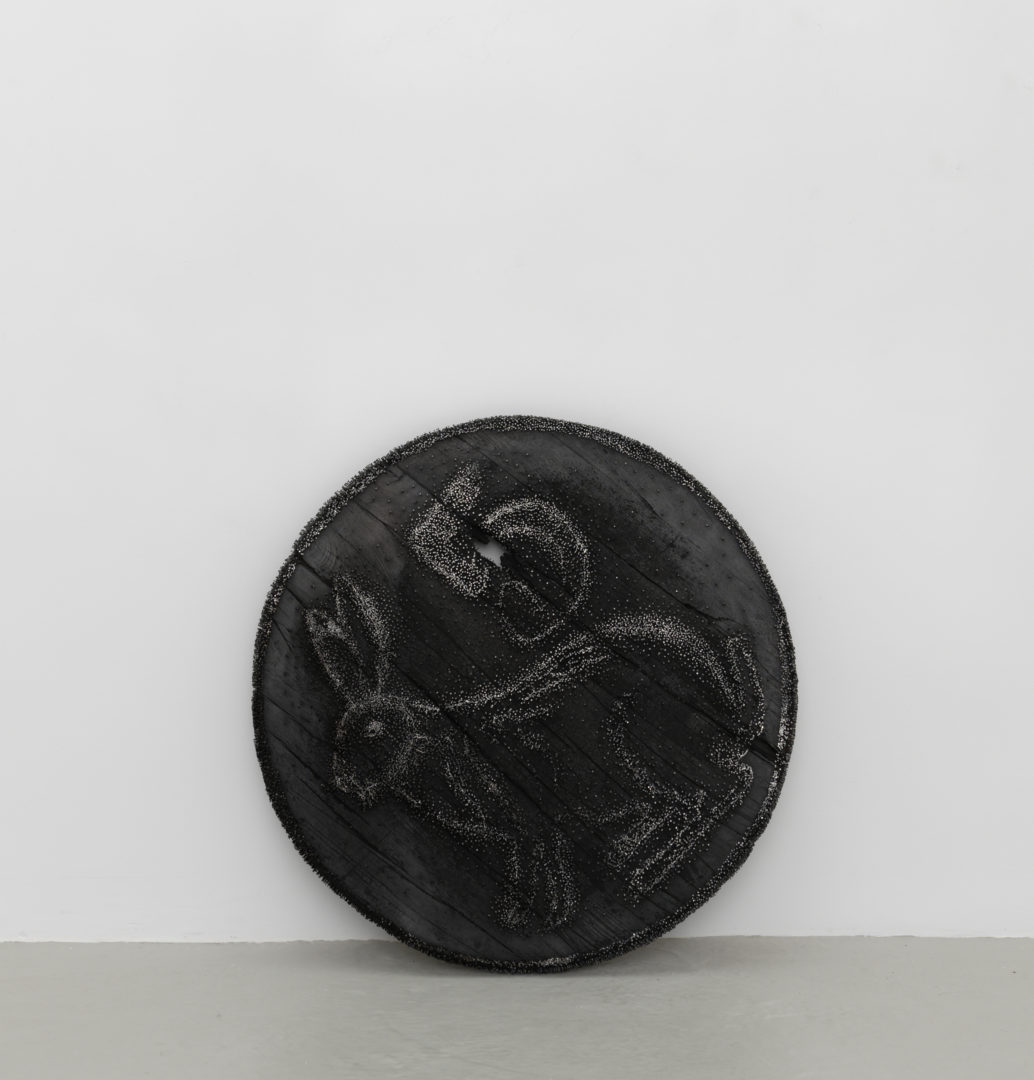Moffat Takadiwa

Bottle tops, toothbrush heads, computer keyboard keys, perfume sprays… Moffat Takadiwa’s plastic repertoire comes from second-hand markets and rubbish tips in Harare, Zimbabwe’s capital. Unlike the compressed, unusable plastics that arrive by boat in other West African countries, these scraps are bought and then integrated into Zimbabwe’s informal economy. Landlocked and with no border with the ocean, the country, by repairing or repurposing imported objects, takes an alternative approach to waste management in Western countries. According to the artist, this is an African ecology, where nothing is really thrown away. His work becomes a kind of artistic extension of this national ecology, thanks to the resources of a local and parallel economy. It’s a makeshift economy, supported by a multitude of intermediaries, that researcher Morad Montazami describes as “suburban “1. This interconnection of spaces, delineated as the north and south of our globalised geography, is the subject of the artist’s first solo exhibition in an institution in France, the Édouard Manet gallery in Gennevilliers. The exhibition follows the ‘Tales of the Grande Rivière’, the waterways that carry piles of goods from African ports to European ports like Gennevilliers.

04.04 – 01.06.2024, Galerie Édouard Manet, Centre d’art contemporain, Gennevilliers.
Photos : Aurélien Mole. Courtesy Semiose, Paris.
Within this global economic fabric of waste treatment, Moffat Takadiwa has developed a precise creative process, a kind of microeconomy. Every day, a team of around twenty people explores second-hand markets and landfill sites in search of materials to buy. In the profusion of what is available – vehicles, telephones, fake hair, bottles – the focus is on products that are commonplace and ordinary in the West, consumer goods that perpetuate colonial domination by imposing themselves on daily life, shaping lifestyles to better control the dominated peoples. A mental bludgeoning diluted in artificial forms of consumption and desire that the artist sums up in the title of one of his works: Land of Coca-Cola and Colgate, presented in the exhibition ‘Demain est annulé’ at the Fondation EDF in Paris, on view until September 2024.
Another team of around ten people, this time in the studio, processes these elements according to a systematic protocol: sorting, cleaning, classifying by colour, perforating.
The artist first lets himself be guided by the quantities obtained, making assumptions about the provenance of certain materials at a given moment, to sketch out several narrative threads. He then unrolls them according to formal compositions, internal motifs and intuitive contours. His preparatory drawings, made on the floor and in actual size, are then entrusted to another team, who meticulously weave and assemble all the components using fishing line. Each stage can only be achieved through a collective effort, and through a “feeling of joy”, to use the artist’s words, in working together. He sees each participant as a craftsman who, without necessarily having any particular technical training, demonstrates great rigour, a capacity for concentration and repetition, as well as demanding manual dexterity.
Despite the almost mechanical nature of the production process, which might seem strict and inflexible, the artist welcomes the mistakes and unforeseen events of all those hands at work, which sometimes deviate from the initial project, take the work in other directions or multiply the layers of understanding. Each work is born of a formal weave, but also draws on a conceptual weave, unfolding several concomitant narratives: mythological, political, economic. Symbols are woven through them, with interpretations that vary according to the way in which they are perceived. The star symbolises both unity in African culture and the soft power of the American film industry. In this semantic fractal, the titles provide clues. For example, it’s not just any bird, but the Zimbabwe Bird, which itself is not understood simply as an animal species, but rather as a metaphorical emblem of the country’s ancestral creation, which in turn serves as an affirmation of national identity at the time of independence. The eagle, a savannah warrior who is said to have guided the starving original population, has appeared on the Zimbabwean dollar and the country’s flag since 1980. Similarly, in Fixable Mistake, the crocodile-like contours suggest the idea of an imminent threat, that of latent neo-colonial domination that can always resurface; it is also an in-between, between land and water, that possesses within it a force of reversal and inversion to the benefit of the dominated.
Moffat Takadiwa manages to combine a post-industrial, post-Internet aesthetic with organic forms. Here, we see large mutant biological cells; there, topographical views of agricultural crops. Each layer of interpretation is interwoven with the other through visual effects and the relief of assembly, as if the abstraction of the weave were pointing to a language of codes, signs and representations. This notion of language is all the more crucial for the artist in that it ties in with Zimbabwe’s colonial history, since Shona – one of the official languages – is “a combination of five indigenous languages and, as such, a European construct “2. Against this linguistic dispossession, the artist invents new alphabets from dislocated Qwerty keyboards, a new language that resists colonial authority through language, which he calls Broken English. Hesitant, stammering combinations of letters, almost stuttering because of the repetition of the keys, to the point of rendering language inoperative. Perhaps we can also see lines of code whose tactility is disconnected from a computer system, thus formulating a critique of this technological language that has become a standardised norm.

04.04 – 01.06.2024, Galerie Édouard Manet, Centre d’art contemporain, Gennevilliers.
Photos : Aurélien Mole. Courtesy Semiose, Paris.
All these computer and calculator keys, all these toothbrush heads, all refer back to the body of each and every one of us. An ordinarity that binds together the millions of anonymous hands and teeth that these scraps have known. In this way, the artist reverses the process of exoticization that normally confines African cultural productions. He elevates the waste to a sacred rank, in almost ritualistic and totemic hangings. In this way, he replaces the artefacts of beliefs assigned to Africanness with shreds of Western civilisation. This reappropriation of strangeness also involves a decolonial reappropriation of craft techniques. Even more than the traditional separation between art and craft, Western canonisation has dispossessed African cultures of their craft traditions, by excluding them from the history of art, forgetting that ancestral techniques predate the Arts and Crafts movement given as its founder, and forgetting that the raw materials for Western crafts were supplied by the triangular trade. Moffat Takadiwa advocates a return to an African way of working, not just a way of doing things but a philosophy, in which simple work is transcended by situated, embodied knowledge that underpins its value. On the surface of his works, this translates into similarities with weaving, as in The Seedbed, where the elements are woven in a loom-like pattern; similarities with jewellery, as in The Urinari/Chinjausi, where the iridescence of aluminium evokes majestic finery; similarities with paving, as in White Circle, where the circle of black and white touches is reminiscent of mosaic patterns.
His decolonial thinking is not just plastic, it also unfolds conceptually, when he chooses to materialise political decisions, for example in the work 1930 Land Apportionment Act, where the two-colour process (black and white) is not chosen at random and draws a fragmented and constrained geography. It also takes up economic realities such as galloping inflation and the devaluation of the local currency. For example, the work 5 cents is both a coin, enlarged and struck with nails that reveal a rabbit, a mythologically powerful creature supposed to bring good luck, and a sculpture made from burnt railway sleepers, symbols of colonial infrastructure. The system of economic, political and administrative domination is thus disassembled as it is assembled. Moffat Takadiwa, born just after Zimbabwe’s independence, is dismantling the remnants of this system. All the dislocated keyboards are those of a certain era, belonging more to the past than to ultra-technological modernity. A colonial past that is expressed in this bureaucracy, treating individuals as numbers behind standardised procedures. He sometimes uses colonial furniture, like an old wooden desk, which he burns and covers with roses, suggesting the possibility of cultivating solutions that are emancipated from those imposed by others.
Like the roses, the artist sometimes slips organic elements into the middle of this plastic mass. It’s a way of summoning up her rural family history, which can be seen in the silhouettes of certain works that capture the details of a rationalised, industrialised agricultural landscape, as well as in certain titles such as the Farm Payslip series. His work also reflects on our relationship with agriculture. The African continent is seeing its natural resources plundered to feed the world in a globalised export system, where the share that goes to farmers is only that of their labour. From her childhood landscape, the tobacco fields, the artist retains and resituates in her works an ecological relationship with the world, a desire to revalue these workers who are never considered for the nurturing role that falls to them. From a decolonial perspective, her works are a way of reminding us that intensive agriculture is nothing more than an eternal restart of the triangular trade, since the dominant crops – tobacco, cotton, coffee and maize – meet Western needs. Mashed Potato is also a reminder of the food conditioning imposed on indigenous populations in the interests of efficiency and profitability, to the detriment of local agricultural wealth.
The artist pushes decolonial thinking to the heart of the museum institution, pursuing through her choices of hanging, what Françoise Vergès calls for: the decolonisation of the museum. For his first solo exhibition in Zimbabwe, at the National Gallery of Zimbabwe, entitled “Vestiges of Colonialism”, he proposed a new relationship with the works for the public, with sculptures detached from the white walls, taking shape in the space, suspended or on the floor, a display that distances itself from Western museographic canons.
Finally, it is important to emphasise that Moffat Takadiwa co-founded the Mbare Art Space, a militant place, conceived and activated as “a district dedicated to the arts, a kind of creative social centre, with the intention of providing the residents of Harare and the surrounding area with a cultural tool adapted to their needs and open to a wide range of artistic practices “3.
1.Morad Montazami, “A conversation with Moffat Takadiwa”, Pleased to meet you, no 13, Sémiose éditions, January 2022, p. 7.
2.Ibid, p. 9.
3.Ibid. p. 9.

5 Cents, 2023
Clous sur bois de table brulée / Nails on burn table burned
Photo : A. Mole
Courtesy Semiose, Paris
head image :
- From the issue: 109
- Share: ,
- By the same author: Stanislas Paruzel at 40mcube, EuroFabrique In Romania, June Crespo, Mathilde Rosier et Ana Vaz at CRAC Altkirch,
Related articles
Ralph Lemon
by Caroline Ferreira
Ho Tzu Nyen
by Gabriela Anco
Hilma af Klint
by Patrice Joly

